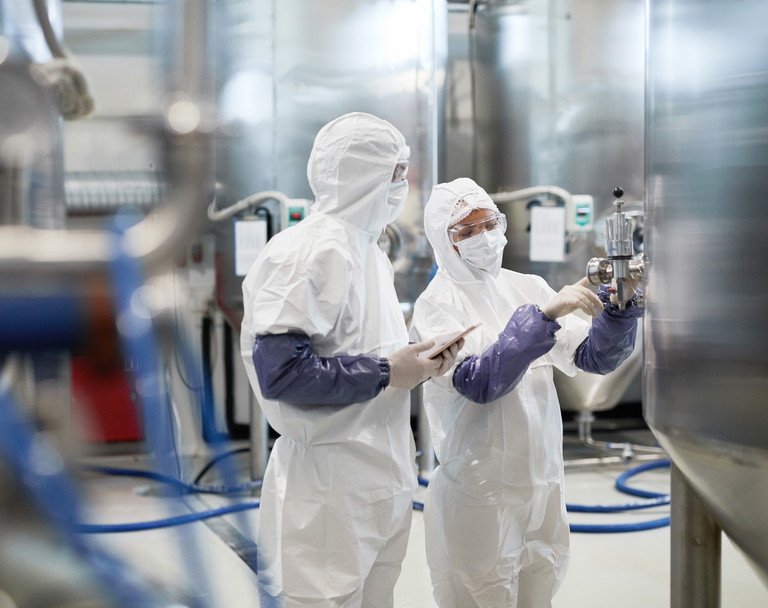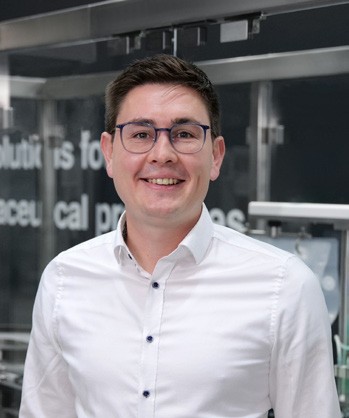Manufacturing: Sustainability in Pharma Manufacturing
Pharma manufacturing: cooperation for sustainable change
Sustainability is top of the agenda for many pharmaceutical manufacturing companies. Which role do technology providers and their equipment play in reducing CO2 emissions
Markus Burkert at Syntegon Technology
The pharmaceutical industry is often seen as a field of contrasts. On the one hand, new medications significantly extend patients’ lives, while on the other, the costs of pioneering treatments continue to rise, and resource consumption surpasses that of most other sectors. Many pharmaceutical companies are currently reassessing their processes with a strong focus on sustainability. Technology providers can support them in reaching their ambitious targets, contributing to a more sustainable pharmaceutical sector while fostering valuable partnerships.
With approximately 20,000 companies worldwide, the pharmaceutical industry is not only a major player in the global market, but also has a substantial impact in terms of revenue and emissions.1 According to a recent report from My Green Lab, which is based on an expanded data set of public and private companies, the total carbon emissions in the biotech and pharma sectors (Scopes 1, 2 and 3) reached 397 million tonnes of carbon dioxide equivalent (CO2 e) in 2023.2 The industry’s carbon emissions even significantly exceed those of the automotive industry by 55%.3
This puts pharmaceutical manufacturing companies under considerable pressure: they must deliver high quality life-saving medicines within strict timelines while simultaneously reducing the environmental footprint of their production processes. Achieving this balance requires lower-emission technologies, fuelling competition for forward-thinking solutions. 80% of the largest companies in the International Federation of Pharmaceutical Manufacturers and Associations want to reduce their emissions as far as possible, or even achieve CO2 neutrality.4

The role of technology providers
Leading market players are also setting themselves ambitious goals beyond the association. Despite varying approaches, they share a clear vision – one with far-reaching implications extending beyond the pharmaceutical manufacturing companies themselves. A key focus is on optimising production facilities to reduce media and energy consumption, driving demand for equipment suppliers with a dedicated sustainability strategy and a more energy-efficient machine portfolio. Carbon footprint assessments, science-based targets and sustainability reporting are becoming central topics for both contract manufacturers and technology providers.
The latter play a crucial role in the pharmaceutical industry’s sustainability strategy, as equipment emissions are factored into the carbon footprints of all pharmaceutical manufacturing companies. Due to the long lifespan of such equipment, its impact on overall emissions extends over several decades. This makes technology providers a key lever for CO2 reduction: by continuously improving their machines and developing more energy-efficient solutions, they can support pharmaceutical manufacturers in reaching their sustainability goals.
Carbon footprint: a boost for decision-making
Assessments by agencies such as EcoVadis, which rate companies on various sustainability criteria, confirm that they act sustainably and in accordance with international standards.5 Certificates also help technology providers to position themselves as environmentally conscious, facilitating the dialogue with like-minded organisations on the pharmaceutical production side. Participating in platforms such as CDP (formerly known as Carbon Disclosure Project) or the Science Based Targets Initiative (SBTi) further increases transparency and sets clear, publicly available targets for improvement.6,7 Technology suppliers disclose their own emissions and carbon footprint, and equipment emissions have become crucial for purchasing decisions and now rank equal with the technology, its market price and its total cost of ownership.
Technology suppliers have additional areas of action, particularly in the use of software-based CO2 analyses, which are becoming valuable tools. Processing and packaging equipment generate emissions that can be measured and assessed across their entire life cycle. These analyses primarily focus on the use phase, which accounts for the majority of total emissions. Key parameters include thermal energy release, electrical power consumption, compressed air usage and other media. CO2 reports provide pharmaceutical companies with a data-driven basis for investment decisions aimed at achieving their reduction targets. At the same time, machine manufacturers can leverage this data to identify opportunities for future technological improvements at an early stage.
Focusing on production
The supply chain, which plays a key role in most pharmaceutical sustainability strategies, underlines this approach. Knowing the carbon footprint of certain machines can provide orientation and support decision-making, such as for alternative production processes. For example, pharmaceutical companies can use both a membrane-based and a distillation process to produce water for injection (WFI) for parenteral applications. Due to the cold process, membrane-based WFI units produce significantly lower CO2 emissions than the established hot processes.
Sometimes, even small changes can make a huge difference, as the example of pure steam generation shows. Upgrades contribute to resource savings; a timer can control the blowdown quantity, ie, the discharge of residual materials by discarding boiling water. The installation of a preheater for the feed water enables pharmaceutical manufacturers to reduce the heating steam input for the entire process, while a night setback for production-free periods notably reduces energy consumption. Software updates, in turn, can lower energy and water use for distillation units in standby mode. Green steel is another lever: if used comprehensively when building new equipment, and provided it is powered by sustainably generated energy, the total carbon footprint can be reduced.
Alternative packaging materials
Downstream processes also present significant savings potential, particularly through the use of innovative, alternative packaging materials. While liquid pharmaceuticals require glass and single-use plastic for primary packaging, which leave little room for change, recyclable and biodegradable solutions are gaining importance in the packaging of solid dosage forms. For primary packaging of tablets and capsules, blister packs made from paper or recyclable polypropylene (PP) offer a viable alternative to conventional polyvinyl chloride thermoforming films. In secondary packaging, cartons remain the predominant choice.
“ Key levers will include reducing media and energy consumption, minimising waste in production, transport and packaging, and optimising operational efficiency ”
Packaging technology providers and paper suppliers have long been developing solutions that can be seamlessly integrated into existing production lines. Paper-based push-through blister packs for tablets and capsules, for instance, are suitable for nutraceuticals, offering both a protective barrier and a heat-sealable layer. Rather than introducing entirely new packaging technologies, which would generate additional emissions, technology providers focus on adaptable line concepts that facilitate efficiency gains. At the same time, continuous innovations remain essential. A comprehensive range of services, from material analysis and packaging development to testing in dedicated development centres, strengthens collaboration and drives the creation of future-ready packaging materials and machine solutions.
Laying the foundations for a sustainable future together
The pharmaceutical industry is taking important steps towards the goal of climate neutrality – especially companies that already have a comprehensive sustainability strategy in place. This shift will extend beyond large pharmaceutical corporations to include contract manufacturers and smaller production companies. Technology providers will continue to capitalise on this momentum, building long-term partnerships with pharmaceutical manufacturing companies. Key levers will include reducing media and energy consumption, minimising waste in production, transport and packaging, and optimising operational efficiency. Additionally, software updates for existing machines and CO2 analyses will serve as valuable tools for enhancing energy efficiency. Technology partners that have proactively developed and implemented their own sustainability strategies early on will gain a significant competitive advantage. By offering additional energy-saving options and introducing resource-efficient equipment solutions, they position themselves as key enablers of more sustainable pharmaceutical production.
Together with pharmaceutical manufacturing companies, they contribute to a pharmaceutical ecosystem where sustainability is deeply integrated into every stage of the value chain. By continuously refining machine performance, reducing energy consumption, and aligning with evolving regulatory and environmental standards, they help establish an innovation-driven approach that ensures lasting environmental responsibility and economic viability.
References
- Visit: api-publishing.com/shop/pharmaceuticals/international_directory_of_pharmaceutical_companies/
- Visit: mygreenlab.org/blog-beaker/the-carbon-impact-ofbiotech-pharma-2024
- Visit: brighterworld.mcmaster.ca/articles/big-pharmaemits-more-greenhouse-gases-than-the-automotiveindustry/
- Visit: ifpma.org/news/joint-industry-statement-byabpi-efpia-farmindustria-imc-ifpma-jpma-leem-phrmaand-vfa-on-the-un-climate-change-conference-cop26-biopharmaceutical-industry-actions-to-tackle-climatechange/
- Visit: ecovadis.com/
- Visit: cdp.net/en
- Visit: sciencebasedtargets.org/

Markus Burkert is product manager for sustainability at Syntegon Technology. He has a degree in industrial engineering. After university he worked as a project manager in the oil and gas industry, followed by several years in the pharmaceutical packaging industry. In January 2023, he joined Syntegon as a product manager for sustainable pharmaceutical filling machines. Markus’ focus is the successful implementation of the CO2 footprint calculation for all Syntegon pharma processing machines including full customer support. This includes identifying possible CO2 levers, deriving the necessary machine modifications and establishing a continuous improvement of the standardisation of machine platforms.